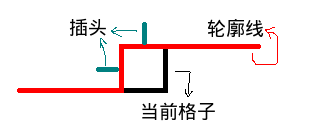[插头DP]HDU1693【Eat the Trees】题解
题目概述
给出 $n\times m$ 的网格图,其中有些格子是障碍,求有多少种方法用若干个哈密顿回路覆盖没有障碍的格子。
解题报告
万年神坑插头DP,插头DP可以解决棋盘上的一些连通性问题(比如这题)。插头指的是一个格子与周围格子的连通情况,插头DP通过记录轮廓线上的插头状态来进行转移。
因为转移时轮廓线上只有两个位置的状态改变了,所以我们只需要关注这两个位置:
由于可以用若干条哈密顿回路,观察之后我们发现只需要知道这两个位置上是否连有插头即可,就可以进行转移:
- A有插头,B有插头:当前格子一定有上插头和左插头,否则连不起来。
- A有插头,B没有插头:当前格子一定有左插头,还可以有右插头或下插头(取决于右边或者下面是不是障碍,且不能同时有右插头和下插头),不能有上插头。
- A没有插头,B有插头:当前格子一定有上插头,还可以有右插头或下插头(取决与右边或者下面是不是障碍,且不能同时有右插头和下插头),不能有左插头。
- A没有插头,B没有插头:当前格子一定有右插头和下插头,因为每个格子都有两个插头。
还有障碍格子的转移问题,因为障碍格子不能连进来也不能连出去,所以直接传递就行了。
示例程序
#include<cstdio>
using namespace std;
typedef long long LL;
const int maxn=11,maxs=1<<maxn+1;
int te,n,m,pic[maxn+5][maxn+5];LL f[2][maxn+5][maxs];
int main(){
freopen("program.in","r",stdin);freopen("program.out","w",stdout);
for (int t=(scanf("%d",&te),1);t<=te;t++){
scanf("%d%d",&n,&m);for (int i=1;i<=n;i++) for (int j=1;j<=m;j++) scanf("%d",&pic[i][j]);
for (int s=0;s<(1<<m+1);s++) f[0][m][s]=0;f[0][m][0]=1;
for (int i=1,c=1;i<=n;i++,c^=1){
for (int j=0;j<=m;j++) for (int s=0;s<(1<<m+1);s++) f[c][j][s]=0;
for (int s=0;s<(1<<m+1);s++) if (f[c^1][m][s]) f[c][0][s<<1]=f[c^1][m][s];
for (int j=1;j<=m;j++)
for (int s=0;s<(1<<m+1);s++){
LL F=f[c][j-1][s];bool A=s>>j-1&1,B=s>>j&1;
if (!pic[i][j]) {if (!A&&!B) f[c][j][s]+=F;}
else if (A&&B) f[c][j][s^(1<<j-1)^(1<<j)]+=F;
else if (A&&!B){
if (pic[i][j+1]) f[c][j][s^(1<<j-1)^(1<<j)]+=F;
if (pic[i+1][j]) f[c][j][s]+=F;
} else if (!A&&B){
if (pic[i][j+1]) f[c][j][s]+=F;
if (pic[i+1][j]) f[c][j][s^(1<<j-1)^(1<<j)]+=F;
} else if (pic[i][j+1]&&pic[i+1][j]) f[c][j][s^(1<<j-1)^(1<<j)]+=F;
}
}
printf("Case %d: There are %lld ways to eat the trees.\n",t,f[n&1][m][0]);
}
return 0;
}版权声明:本博客所有文章除特别声明外,均采用 CC BY 4.0 CN协议 许可协议。转载请注明出处!
请不要发毫无意义或内容不文明的评论。与本文无关评论请发留言板!


